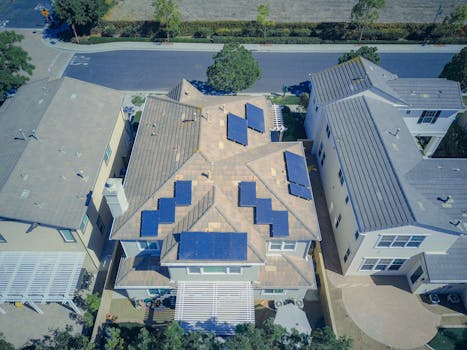“Empower Your Home: Build Your Own DIY Solar Battery System!”
DIY solar battery systems are an increasingly popular solution for individuals looking to harness renewable energy and achieve energy independence. By building your own solar battery system, you can store excess energy generated from solar panels for use during nighttime or cloudy days, reducing reliance on the grid and lowering electricity bills. This guide will walk you through the essential components, tools, and steps needed to create a functional and efficient solar battery system tailored to your energy needs. With careful planning and execution, you can create a sustainable energy solution that not only benefits your household but also contributes to a greener planet.
Choosing the Right Solar Batteries for Your DIY System
When embarking on the journey of building your own DIY solar battery system, one of the most critical decisions you will face is choosing the right solar batteries. The type of battery you select will significantly influence the efficiency, longevity, and overall performance of your solar energy setup. Therefore, understanding the various battery technologies available is essential for making an informed choice.
First and foremost, it is important to consider the different types of batteries commonly used in solar applications. Lead-acid batteries, including both flooded and sealed variants, have been a staple in the industry for many years. They are relatively inexpensive and widely available, making them an attractive option for beginners. However, they do have some drawbacks, such as a shorter lifespan and lower depth of discharge compared to other technologies. This means that while they can be a cost-effective solution, they may require more frequent replacements and may not utilize the full capacity of the battery without risking damage.
On the other hand, lithium-ion batteries have gained popularity in recent years due to their superior performance characteristics. They offer a higher energy density, which means they can store more energy in a smaller footprint. Additionally, lithium-ion batteries have a longer lifespan and can be discharged more deeply without suffering from damage, making them a more efficient choice for many solar applications. However, it is important to note that they come with a higher upfront cost, which may be a consideration for those on a tight budget.
As you weigh your options, it is also crucial to consider the specific energy needs of your household or project. This involves calculating your daily energy consumption and determining how much energy you will need to store for use during periods of low sunlight. By understanding your energy requirements, you can better assess the capacity and number of batteries needed for your system. For instance, if you live in an area with frequent cloudy days or plan to use a significant amount of energy during the night, investing in a larger battery bank may be necessary to ensure a reliable power supply.
Moreover, the compatibility of the batteries with your solar inverter and charge controller is another vital factor to consider. Different battery types have varying charging and discharging characteristics, which can affect the overall efficiency of your system. Therefore, it is essential to ensure that your chosen batteries are compatible with the other components of your solar setup. This may involve consulting the specifications of your inverter and charge controller to confirm that they can handle the voltage and current requirements of your selected batteries.
In addition to these technical considerations, it is also wise to think about the environmental impact of your battery choice. While lead-acid batteries are recyclable, they can pose environmental hazards if not disposed of properly. Conversely, lithium-ion batteries, while more environmentally friendly in terms of energy efficiency, also require responsible recycling practices due to the materials used in their construction. Therefore, researching the recycling options available in your area can help you make a more sustainable choice.
Ultimately, choosing the right solar batteries for your DIY system involves a careful evaluation of your energy needs, budget, and the specific characteristics of the battery technologies available. By taking the time to understand these factors, you can build a solar battery system that not only meets your energy requirements but also contributes to a more sustainable future. With the right batteries in place, you will be well on your way to harnessing the power of the sun and enjoying the benefits of renewable energy in your home.
Step-by-Step Guide to Assembling a Solar Battery Bank
Building your own solar battery bank can be a rewarding and cost-effective way to harness solar energy for your home. By following a systematic approach, you can create a reliable energy storage system that complements your solar panel setup. The first step in assembling a solar battery bank is to gather the necessary materials. You will need deep-cycle batteries, a battery management system (BMS), a charge controller, wiring, and a suitable enclosure to house the batteries. It’s essential to choose batteries that are designed for solar applications, as they are built to withstand the deep discharges that come with energy storage.
Once you have all your materials, the next step is to determine the layout of your battery bank. This involves deciding how many batteries you will use and how they will be connected. Typically, batteries can be wired in series, parallel, or a combination of both, depending on your voltage and capacity requirements. For instance, if you need a higher voltage, you can connect batteries in series, while connecting them in parallel will increase the overall capacity. It’s crucial to calculate your energy needs accurately to ensure that your battery bank can store enough energy to meet your demands.
After planning the layout, you can begin the assembly process. Start by placing the batteries in the enclosure, ensuring they are stable and secure. It’s advisable to use a non-conductive surface to prevent any accidental short circuits. Once the batteries are positioned, you can begin connecting them according to your planned configuration. Use high-quality, appropriately sized cables to ensure efficient energy transfer and minimize losses. When connecting the batteries, always follow safety protocols, such as wearing gloves and goggles, to protect yourself from potential hazards.
With the batteries connected, the next step is to install the battery management system. The BMS is crucial for monitoring the health of your battery bank, preventing overcharging, and ensuring balanced charging across all batteries. Follow the manufacturer’s instructions for wiring the BMS, as it will typically involve connecting it to each battery’s positive and negative terminals. This step is vital for maintaining the longevity and efficiency of your battery bank.
Once the BMS is in place, you can proceed to install the charge controller. The charge controller regulates the voltage and current coming from your solar panels to the battery bank, preventing overcharging and ensuring that the batteries are charged efficiently. Connect the charge controller to both the solar panels and the battery bank, following the wiring diagrams provided by the manufacturer. This step is essential for protecting your investment and ensuring that your solar battery bank operates optimally.
After all components are connected, it’s time to test the system. Before fully integrating your solar battery bank with your home’s electrical system, conduct a thorough check to ensure all connections are secure and that there are no signs of damage or wear. Once you are confident in the setup, you can connect the battery bank to your home’s electrical system, allowing you to store and use solar energy effectively.
In conclusion, assembling a solar battery bank requires careful planning, attention to detail, and adherence to safety protocols. By following these steps, you can create a reliable energy storage solution that enhances your solar power system, ultimately leading to greater energy independence and sustainability. As you embark on this DIY project, remember that patience and precision are key to achieving a successful outcome.
Essential Tools and Materials for DIY Solar Battery Projects
Building your own solar battery system can be a rewarding and cost-effective way to harness renewable energy for your home. However, before embarking on this project, it is crucial to gather the essential tools and materials that will ensure a successful installation. Understanding what you need not only streamlines the process but also enhances safety and efficiency.
To begin with, a reliable power source is fundamental. Solar panels are the heart of your system, converting sunlight into electricity. When selecting solar panels, consider their wattage and efficiency ratings, as these factors will determine how much energy you can generate. Additionally, you will need a charge controller, which regulates the voltage and current coming from the solar panels to the batteries, preventing overcharging and extending battery life. Choosing a charge controller that matches your system’s voltage and capacity is vital for optimal performance.
Next, batteries are essential for storing the energy generated by your solar panels. Deep-cycle batteries, such as lead-acid or lithium-ion types, are commonly used in solar applications due to their ability to discharge and recharge repeatedly. When selecting batteries, consider their capacity, measured in amp-hours (Ah), as this will dictate how much energy you can store for later use. It is also wise to invest in battery connectors and terminal lugs to ensure secure and efficient connections.
In addition to these primary components, you will need various tools to facilitate the assembly of your solar battery system. A multimeter is indispensable for measuring voltage, current, and resistance, allowing you to troubleshoot and ensure that your system is functioning correctly. Wire strippers and crimping tools are also necessary for preparing and connecting wires, ensuring that all connections are secure and reliable. Furthermore, a drill and appropriate drill bits will be useful for mounting solar panels and securing other components.
Wiring is another critical aspect of your DIY solar battery project. You will need appropriately rated cables to connect the solar panels, charge controller, and batteries. It is essential to choose the right gauge of wire to handle the current without overheating. Additionally, fuses or circuit breakers should be included in your system to protect against overloads and short circuits, enhancing safety and reliability.
Moreover, a sturdy mounting system is necessary to secure your solar panels in place. Depending on your installation location, you may require roof mounts, ground mounts, or pole mounts. Ensure that the mounting system is compatible with your solar panels and can withstand local weather conditions. Having the right mounting hardware, such as brackets and bolts, will facilitate a stable installation.
Lastly, safety equipment should not be overlooked. Personal protective equipment, such as gloves and safety glasses, is essential when working with electrical components. Additionally, having a fire extinguisher nearby is a prudent precaution, as it can help mitigate risks associated with electrical fires.
In conclusion, embarking on a DIY solar battery project requires careful planning and the right tools and materials. By gathering solar panels, charge controllers, batteries, wiring, and essential tools, you can create a reliable and efficient solar battery system. Prioritizing safety and ensuring that all components are compatible will lead to a successful installation, allowing you to enjoy the benefits of renewable energy in your home. With the right preparation, you can take a significant step toward energy independence and sustainability.
Common Mistakes to Avoid When Building a Solar Battery System
Building a DIY solar battery system can be an empowering and cost-effective way to harness renewable energy for your home. However, as with any complex project, there are common pitfalls that can lead to inefficiencies, safety hazards, or even complete system failure. By understanding these mistakes, you can navigate the process more effectively and create a reliable solar battery system that meets your energy needs.
One of the most frequent errors made by DIY enthusiasts is underestimating the importance of proper planning. Before diving into the construction phase, it is crucial to assess your energy requirements accurately. This involves calculating your daily energy consumption and determining how much energy you want to store. Failing to do so can result in a system that is either overbuilt, leading to unnecessary expenses, or underbuilt, which may leave you without sufficient power during peak usage times. Therefore, take the time to gather data on your energy usage and consider future needs as well.
Another common mistake is neglecting to choose the right components for your solar battery system. Many DIY builders may opt for cheaper or incompatible parts, thinking they can save money. However, using low-quality batteries, inverters, or charge controllers can compromise the efficiency and longevity of your system. It is essential to invest in high-quality components that are compatible with each other and suitable for your specific energy requirements. Researching reputable brands and reading reviews can help you make informed decisions that will pay off in the long run.
Moreover, improper installation is a significant issue that can lead to safety hazards and system inefficiencies. For instance, failing to follow the manufacturer’s guidelines for wiring and connections can result in short circuits or even fires. Additionally, neglecting to secure the batteries properly can lead to physical damage or leaks, especially if you are using lead-acid batteries. To avoid these problems, take the time to familiarize yourself with installation best practices and consider consulting with experienced individuals or resources to ensure that you are following safe and effective procedures.
Furthermore, many DIY builders overlook the importance of monitoring and maintenance. Once your solar battery system is up and running, it is easy to forget about it, but regular checks are essential for optimal performance. This includes monitoring battery levels, checking for corrosion on terminals, and ensuring that all connections remain secure. Neglecting these tasks can lead to decreased efficiency and a shorter lifespan for your system. Establishing a routine maintenance schedule can help you catch potential issues early and keep your system running smoothly.
Lastly, it is vital to consider local regulations and safety codes when building your solar battery system. Many regions have specific guidelines regarding electrical installations, and failing to adhere to these can result in fines or even the need to dismantle your system. Before starting your project, research local laws and regulations to ensure compliance. Additionally, obtaining necessary permits can help you avoid legal complications down the line.
In conclusion, while building a DIY solar battery system can be a rewarding endeavor, it is essential to be aware of common mistakes that can hinder your success. By planning thoroughly, selecting quality components, ensuring proper installation, committing to regular maintenance, and adhering to local regulations, you can create a reliable and efficient solar battery system that meets your energy needs for years to come. With careful attention to these details, you can enjoy the benefits of renewable energy while avoiding the pitfalls that many DIY builders encounter.
Q&A
1. **Question:** What materials do I need to build a DIY solar battery system?
**Answer:** You will need solar panels, a charge controller, batteries (preferably deep cycle), an inverter, wiring, and mounting hardware.
2. **Question:** How do I connect the solar panels to the batteries?
**Answer:** Connect the solar panels to the charge controller, then connect the charge controller to the batteries. Ensure the connections are secure and follow the manufacturer’s wiring diagrams.
3. **Question:** What type of batteries are best for a DIY solar battery system?
**Answer:** Deep cycle lead-acid batteries or lithium-ion batteries are recommended, as they can handle repeated charging and discharging cycles effectively.
4. **Question:** How do I size my solar battery system?
**Answer:** Calculate your daily energy consumption in watt-hours, then determine the total wattage of your solar panels and the capacity of your batteries to ensure they can meet your energy needs.
Conclusion
Building your own DIY solar battery system can be a rewarding and cost-effective way to harness solar energy for personal use. By carefully selecting components such as solar panels, charge controllers, batteries, and inverters, and following a systematic approach to installation and safety, individuals can create a reliable energy storage solution. This not only promotes energy independence but also contributes to sustainability efforts. However, it is essential to conduct thorough research, understand local regulations, and prioritize safety to ensure a successful and efficient system.




